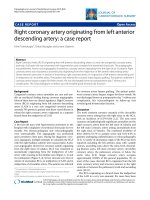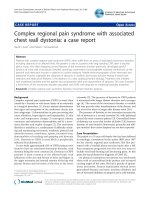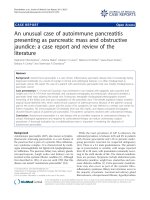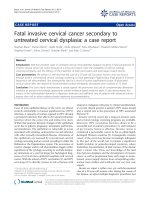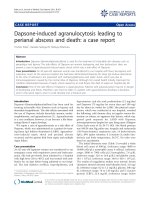Báo cáo y học: "An unusual foreign body as cause of chronic sinusitis: a case report." ppsx
Bạn đang xem bản rút gọn của tài liệu. Xem và tải ngay bản đầy đủ của tài liệu tại đây (511.02 KB, 4 trang )
JOURNAL OF MEDICAL
CASE REPORTS
Kelesidis et al. Journal of Medical Case Reports 2010, 4:157
/>Open Access
CASE REPORT
BioMed Central
© 2010 Kelesidis et al; licensee BioMed Central Ltd. This is an Open Access article distributed under the terms of the Creative Commons
Attribution License ( which permits unrestricted use, distribution, and reproduction in
any medium, provided the original work is properly cited.
Case report
An unusual foreign body as cause of chronic
sinusitis: a case report
Theodoros Kelesidis*, Sara Osman and Harry Dinerman
Abstract
Introduction: The presence of a foreign body in the nose is a relatively uncommon occurrence. Many unusual foreign
bodies in the nose have been reported in the literature, but no case of a nasal packing occurring as a foreign body in
the nasal cavity for a prolonged time has been found.
Case presentation: We describe a unique case of the largest foreign body left in situ in the nasal cavity for over 10
years. Our patient was a 71-year-old Caucasian man with diabetes. Because of this, he was at high risk of developing
complications from the foreign body and the chronic sinusitis. Amazingly, though, the foreign body had not caused
any symptoms on our patient for many years, except for nasal discharge during the last few years. To the best of our
knowledge, this is the first case in the literature of such a large intra-nasal foreign body described in an adult without
mental illness and without trauma that remained in situ for such a long time.
Conclusion: Undoubtedly, even illnesses with no complications could prove difficult for clinicians to diagnose.
Clinicians should recognize the underlying causes that are responsible for the symptoms of chronic sinusitis and a
unilateral nasal discharge should be assumed to be caused by an intra-nasal foreign body until proven otherwise.
Introduction
The presence of a foreign body in the nose is a relatively
uncommon occurrence. Unlike foreign bodies in other
parts of the body that often produce noticeable symp-
toms, foreign bodies in the nose can go unrecognized for
significant periods of time. A prolonged period of impac-
tion is even less common, but it is more likely when the
foreign body is an inert object. Many unusual foreign
bodies have been reported in the literature, but no case
has been found of a nasal packing occurring as a foreign
body in the nasal cavity for a prolonged time.
Case report
We describe a case of a 71-year-old Caucasian man with
history of underlying cardiomyopathy and type 2 diabetes
mellitus for 20 years. He also had a history of multiple
hospitalizations for congestive heart failure. Our patient
presented to us with worsening leg edema and weight
gain. He had no fever, headache and denied other symp-
toms. However, he was noticed to have a foul smelling
discharge from the right nostril. Upon further assess-
ment, he mentioned that he had this symptom for years,
but never complained about this and he never had a
work-up for this nasal discharge. On physical examina-
tion, he had a temperature of 97.3°F, blood pressure of
110/65 mmHg, and heart rate of 75 beats per minute. He
had a respiratory rate of 18 breaths per minute and an
oxygen saturation of 97% on room air. There was puru-
lent and foul smelling discharge from his right nostril,
which was chronic according to our patient. During ante-
rior rhinoscopy of the right nasal cavity, a hard foreign
body coated with purulent secretions was found. There
was minimal tenderness on percussion of the maxillary
sinuses. Cardiac examination revealed an irregular
rhythm with a grade 2/6 systolic murmur at the apex. He
had minimal crackles bilaterally in his lower posterior
chest. His abdomen was mildly distended and he had pit-
ting edema in his lower extremities, while the rest of the
physical examination was unremarkable.
A complete blood count was unremarkable, showing a
white blood cell count of 7.7 × 10
3
/mm
3
(74% neutro-
phils). A basic metabolic panel revealed chronic stable
renal insufficiency with a serum creatinine of 1.7 mg/dl.
A portable chest X-ray demonstrated marked cardiomeg-
* Correspondence:
1
Department of Medicine, Caritas St Elizabeth's Medical Center, Tufts
University School of Medicine, Boston, MA, USA
Full list of author information is available at the end of the article
Kelesidis et al. Journal of Medical Case Reports 2010, 4:157
/>Page 2 of 4
aly. A computed tomography scan of our patient's sinuses
revealed the presence of extensive sinusitis of the right
and left maxillary sinus and the presence of a calcified
foreign body in the right nostril (Figures 1, 2, 3), leading
to a diagnosis of bilateral sinusitis. On further investiga-
tion, our patient reported having had packing for the
right nostril 12 years ago for a nosebleed. However, he
was not sure if the packing had ever been removed and
did not remember if the cause of his nosebleed was iden-
tified. The foreign body identified in the computed
tomography represents the packing that had remained in
the nostril all these years and became calcified with a
bone like density at certain areas (Figures 1, 2, 3). The for-
eign body was quite large extending to the posterior
nasopharynx and obliterating the drainage of the right
maxillary sinus, causing extensive sinusitis.
However, multiple attempts to remove the foreign
object with different techniques through the anterior
nares, such as use of cupped forceps (including Tilley
nasal forceps), hemostats, curved hooks, Fogarty biliary
catheter, Howarth's periosteal elevator and suction [1] by
ear, nose and throat (ENT) specialist, were unsuccessful.
Our patient refused surgical removal of the foreign body.
He also declined further antimicrobial treatment. He was
discharged after diuresis and resolution of the leg edema.
Discussion
A review of the literature shows that intra-nasal foreign
bodies have been frequently reported especially among
children. Among adults, however, they occur very rarely
and are caused mostly by injury in an accident, trauma or
coexisting mental disorders [2]. In a large study of 420
cases of foreign bodies in the nasal cavity only one adult
case, a homeless man with nasal myiasis was described
[3]. Unusual foreign bodies including buttons have been
described very rarely in adults [4].
The majority of cases of intra-nasal foreign bodies are
asymptomatic, except for a history of a foreign body hav-
ing been inserted in the nose. Common symptoms, if
present, include pain or discomfort, nasal discharge,
nasal congestion or nasal odor. A unilateral mucopuru-
lent nasal discharge with foul odor is the most consistent
Figure 1 Coronal view of the intra-nasal foreign body.
Figure 2 Sagittal view of the calcified nasal packing.
Figure 3 Transverse view of the calcified foreign body. Extensive
sinusitis of the right and left maxillary sinuses is evident.
Kelesidis et al. Journal of Medical Case Reports 2010, 4:157
/>Page 3 of 4
finding in patients with a nasal foreign body [1]. Rare
symptoms have been reported, including bromidrosis
(foul body odor) [5] and infections, such as facial cellu-
lites [6], epiglottitis [7], and cephalic tetanus [8]. Differen-
tial diagnoses of a unilateral nasal obstruction include
nasal polyp, nasal tumor, nasal abscess, septal hematoma,
or unilateral choanal atresia [1].
Many foreign bodies are inert and can remain in the
nose for years without mucosal damage. However, most
foreign objects initiate congestion, swelling of the
mucosa, ulceration, mucosal destruction and epistaxis.
This can result in a foul fetor and rhinolith formation.
Certain foreign bodies, such as vegetable, absorb water
from the tissues and swell and can evoke an intense
inflammatory reaction that can be sufficient to produce
toxemia [9]. Thus, several important complications may
occur with the presence of a nasal foreign body, including
formation and development of rhinoliths, erosion into a
contiguous structure, toxic shock syndrome and develop-
ment of infections in surrounding structures including
acute sinusitis or otitis media, periorbital cellulitis, men-
ingitis, acute epiglottitis, diphtheria, and tetanus [7,8].
Long-standing objects left in body orifices tend to act
as nuclei for concretion to form calculus deposits and
become encrusted with calcified material and granulation
tissue by receiving a coating of calcium, magnesium
phosphate, and carbonate with time. Moreover, various
iatrogenic foreign bodies on patients have been reported
to cause nucleation and deposition of calculi [10]. Simi-
larly, the nasal packing in our case had become calcified.
Interestingly, there are reports of intra-nasal foreign
objects that were left calcified in situ from two to 50 years
[2,9,11]. Most nasal foreign bodies can be easily removed
in the office or emergency department [1,9]. However,
multiple attempts to remove the foreign object in our
patient with different techniques [1] by ear nose and
throat (ENT) specialist were unsuccessful.
This case is unusual and interesting for several reasons.
To the best of our knowledge, the nasal packing in this
case is the largest foreign body left in situ for over 10
years. The foreign body had essentially obliterated the
whole right nasopharynx (Figures 1, 2, 3). Impressively,
although our patient was diabetic and at an increased risk
for development of complications from the foreign body
and the chronic sinusitis including brain abscess, menin-
gitis and toxic shock syndrome, the foreign body had not
caused any symptoms for many years with the exception
of nasal discharge the last few years. According to our
patient, he neither had fever nor headache, and he did not
pay attention to the nasal discharge. Our patient started
having a nasal discharge the last few years that was likely
attributable to the degradation of the foreign body. Deg-
radation products might have produced local mucosal
irritation and the production of excess mucus.
Although we could not determine the nature of the
material of the nasal packing since it was not removed, it
is possible that the nasal packing consisted of a relatively
inert material that did not precipite significant mucosal
damage or inflammatory reaction. Although specific
defects in innate and adaptive immune function have
been identified in diabetic patients, defects in adaptive
immunity, which is important against foreign bodies, are
less well-characterized [12]. Moreover, the link between
glycemic control and the risk of common community-
acquired infections including sinusitis is less established
[12]. Extensive calcification of the foreign body in the set-
ting of microangiopathy in patients with diabetes could
also be a barrier for inflammatory response. Thus, the
presence of an inert, heavily calcified material in an area
with possible microangiopathy could potentially explain
the absence of significant inflammatory response to this
foreign object and its presence in the nasal cavity for so
many years without any complications.
It is noted that our patient lives independently and he is
not known to have a mental illness. Thus, our case, to the
best of our knowledge, represents the first case in the lit-
erature of such a large intra-nasal foreign body described
in an adult without mental illness and without trauma
that remained in situ for such a long time.
Conclusions
Undoubtedly, even illnesses that are not complicated
could prove difficult for clinicians to diagnose. Clinicians
should recognize the underlying causes that are responsi-
ble for symptoms of chronic sinusitis. This case empha-
sizes the importance of history-taking and a broad
differential diagnosis. A unilateral nasal discharge should
be assumed to be caused by an intra-nasal foreign body
until proven otherwise.
Consent
Written informed consent was obtained from our patient
for publication of this case report and any accompanying
images. A copy of the written consent is available for
review by the Editor-in-Chief of this journal.
Competing interests
The authors declare that they have no competing interests.
Authors' contributions
TK analyzed and interpreted the data of our patient and was a major contribu-
tor in writing the manuscript. SO and HD analysed our patient data and con-
tributed in writing the manuscript. All authors read and approved the final
manuscript.
Author Details
Department of Medicine, Caritas St Elizabeth's Medical Center, Tufts University
School of Medicine, Boston, MA, USA
Received: 28 October 2009 Accepted: 26 May 2010
Published: 26 May 2010
This article is available from: 2010 Kelesidis et al; licensee BioMed Central Ltd. This is an Open Access article distributed under the terms of the Creative Commons Attribution License ( which permits unrestricted use, distribution, and reproduction in any medium, provided the original work is properly cited.Journal of Medical Case Repo rts 2010, 4:157
Kelesidis et al. Journal of Medical Case Reports 2010, 4:157
/>Page 4 of 4
References
1. Werman HA: Removal of foreign bodies of the nose. Emerg Med Clin
North Am 1987, 5:253-263.
2. Tay AB: Long-standing intranasal foreign body: an incidental finding on
dental radiograph: a case report and literature review. Oral Surg Oral
Med Oral Pathol Oral Radiol Endod 2000, 90:546-549.
3. Figueiredo RR, Azevedo AA, Kos AO, Tomita S: Nasal foreign bodies:
description of types and complications in 420 cases. Braz J
Otorhinolaryngol 2006, 72:18-23.
4. Pellacchia V, Moricca LM, Buonaccorsi S, Indrizzi E, Fini G: Unusual foreign
body in the nasal cavity. J Craniofac Surg 2006, 17:1176-1180.
5. Katz HP, Katz JR, Bernstein M, Marcin J: Unusual presentation of nasal
foreign bodies in children. JAMA 1979, 241:1496.
6. Waldman LA: Facial cellulitis caused by unrecognized foreign body.
Oral Surg Oral Med Oral Pathol 1979, 48:408-409.
7. Oh TH, Gaudet T: Acute epiglottis associated with nasal foreign body:
occurrence in a 30-month-old girl. Clin Pediatr (Phila) 1977,
16:1067-1068.
8. Sarnaik AP, Venkat G: Cephalic tetanus as a complication of nasal
foreign body. Am J Dis Child 1981, 135:571-572.
9. Kalan A, Tariq M: Foreign bodies in the nasal cavities: a comprehensive
review of the aetiology, diagnostic pointers, and therapeutic
measures. Postgrad Med J 2000, 76:484-487.
10. Cheng PT, Pritzker KP, Richards J, Holmyard D: Fictitious calculi and
human calculi with foreign nuclei. Scanning Microsc 1987, 1:2025-2032.
11. Pitsinis V, Patel A: Foreign body impaction: fifty years inside the nose.
Ear Nose Throat J 2004, 83:564-566.
12. Peleg AY, Weerarathna T, McCarthy JS, Davis TM: Common infections in
diabetes: pathogenesis, management and relationship to glycaemic
control. Diabetes Metab Res Rev 2007, 23:3-13.
doi: 10.1186/1752-1947-4-157
Cite this article as: Kelesidis et al., An unusual foreign body as cause of
chronic sinusitis: a case report Journal of Medical Case Reports 2010, 4:157

